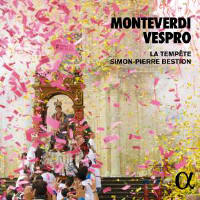Texte paru dans: / Appeared in: |
|
|
Outil de traduction (Très approximatif) |
|
|
Reviewer:
Alexandra Coghlan It takes beats, not bars, to realise that we’re not in Venice anymore with this new recording of Monteverdi’s 1610 Vespers. Or maybe we are, but it’s certainly not the marble-fronted, coolly classical city so many accounts of this work would suggest. La Tempête’s Venice is all cosmopolitan collisions, the crossroads of Europe – busy, dirty, bustling with as many prostitutes as priests. There were clues. First, the running-time of this two-disc set – not the normal 80 or 90 minutes but well over two hours of music. And then there was Simon-Pierre Bestion and La Tempête’s previous recording, their bold ‘Azahar’ (5/17), pairing Machaut’s Messe de Nostre Dame and the Stravinsky Mass (complete with unusual overlap of performing forces). Authenticity holds little interest for Bestion, who admits frankly in his booklet interview that this Vespers bears little resemblance to any Monteverdi might have heard or even imagined, even if he did originally intend this disparate, non-functionally liturgical group of works as a coherent whole. Taking advantage of many of the movements’ lack of specified orchestration, Bestion fills out the texture with a rich combination not just of harpsichords, harps, theorbos and cornetts but also sackbuts, citterns and even a serpent, intended to echo the distinctive call of the Jewish shofar. And then there’s the music itself, often expanded with additional repetitions and filled out with unexpected interpolations; the opening Toccata from Orfeo makes an arresting intrusion into the opening sequence, and elsewhere a Frescobaldi Ricercar sopra Sancta Maria creeps in – a demure prelude to Monteverdi’s more exuberant Sonata. The style of performance is as irreverent and wide-ranging as the musical material. The opening chant, ‘Domine ad adjuvandum me’, bursts acid in the ear, all pitch-bending swoops and frank, folk-like brightness and brilliance of tone. The many ululating ornaments here (and throughout) draw more on Byzantine and Orthodox traditions than on Western Renaissance and Baroque music, fretting at repeated pitches with chromatic quivers and plenty of modal colour. What does it all add up to? A disorientating ritual of daunting scope and size, but one whose distinctive point of view and unapologetic delivery are hard to gainsay. The ensemble-singing can be a bit rough at times and the solo voices are chosen for character rather than classical purity, but this all adds up to some undeniably exciting moments, like the joyous ‘Gloria Patri’ conclusion to the ‘Laudate pueri’, where unison men come joyously close to football-crowd brashness. Judged against its own quirky standards, Bestion’s account makes its case. My only quibble would be that all this novelty and colour can sometimes make the moments of unadulterated Monteverdi seem a little pallid by comparison. |
|




